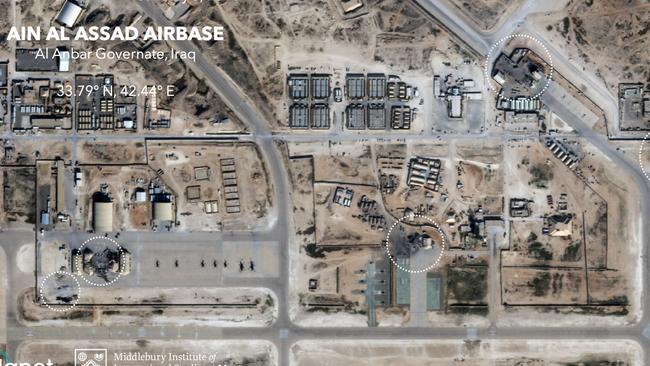Iran showcases missiles fired to send a signal
The Iranian strikes on Iraqi military bases that housed US troops demonstrated a missile arsenal with sophistication, accuracy and reach.

The Iranian strikes on Iraqi military bases that housed US troops, along with the Saudi missile and drone attack attributed to Iran in September, demonstrated a missile arsenal with a sophistication, accuracy and reach capable of threatening and deterring the country’s regional adversaries.
On Wednesday, more than a dozen ballistic missiles were launched from Iran and struck two Iraqi bases — al-Asad in the west and Irbil in the north — in retaliation for the US killing last week of Iranian general Qassem Soleimani.
Most of the missiles detonated and appeared to hit specific military structures, according to Iraqi and US officials. Images released by Planet Labs, a satellite network, appeared to show at least four impact sites.
While it is too early to draw conclusive assessments on the latest attack, analysts say Iran accomplished what it had set out to do: hit the Iraqi bases with enough accuracy to send a signal, but without causing unintended casualties that could cause the confrontation between Tehran and Washington to escalate out of control.
“These were not simple ballistic missiles. They wanted precision guidance,” said Tom Karako, director of the Missile Defence Project at the Washington-based Centre for Strategic and International Studies.
“They didn’t want American blood.”
Killing an American citizen in a missile attack would likely have prompted American retaliation.
Wreckage and published footage of the attack suggested that the ballistic missiles used on Wednesday were most likely of the Qiam model and a variant of the Fateh-110, perhaps a Zulfaghar, said Fabian Hinz, a research associate at the James Martin Centre for Nonproliferation Studies in Monterey, California. The Qiam, an indigenous missile Iran developed about 10 years ago, has a range of up to 800km and is believed to possess an improved guidance system, according to CSIS. The Fateh-110 is a short-range, road-mobile missile, with some of its components believed to come from China.
Since the mid-1980s. Iran has developed one of the region’s largest and most versatile missile programs, most of which is operated by the Islamic Revolutionary Guard Corps.
The program dates back to before the 1979 Islamic Revolution but accelerated during the country’s war against Iraq in the 1980s.
Iran now has hundreds of short- and medium-range ballistic missiles, which it sees as a way to compensate for the limitations of its air force, experts say.
Iran’s air fleet has been hobbled by decades of sanctions, putting it at a disadvantage with rivals in the region, namely Saudi Arabia, with more advanced air power.
“The Iranians see their missile force as an integral and indispensable part of their national defence strategy, fulfilling key strike roles traditionally taken by manned aircraft,” Robert Einhorn and Vann Van Diepen wrote in a Brookings Institution report last year.
The most advanced missile in Iran’s arsenal, a cruise missile named the Soumar, has a presumed range of 1900km, or 2900km if Iran’s claims are true. Ballistic missiles fly in an arc outside the atmosphere, with most of their trajectory unpowered, while cruise missiles are self-navigating and fly in a mostly straight line within the atmosphere, as low as a few yards off the ground, making them harder to detect for radars.
In 2017 and 2018, Iran launched ballistic-missile strikes against Islamic State targets in Syria, attacks that US analysts said appeared intended as a warning to other potential adversaries about Tehran’s capabilities.
In the September attack on oil facilities in eastern Saudi Arabia, Iran used cruise missiles and drones that analysts said were extremely accurate.
“The most important message the Iranians sent to the Americans is that all of their missiles went through the American air defence without a single one being shot down,” Mohammad Marandi, a professor at Tehran University, said of Wednesday’s attack.
“It was a warning shot that said: you can’t stop our missiles.”
The al-Asad and Irbil bases do not house Patriot anti-missile batteries, which can intercept ballistic missiles but aren’t as capable of defending against cruise missiles.
The Wall Street Journal


